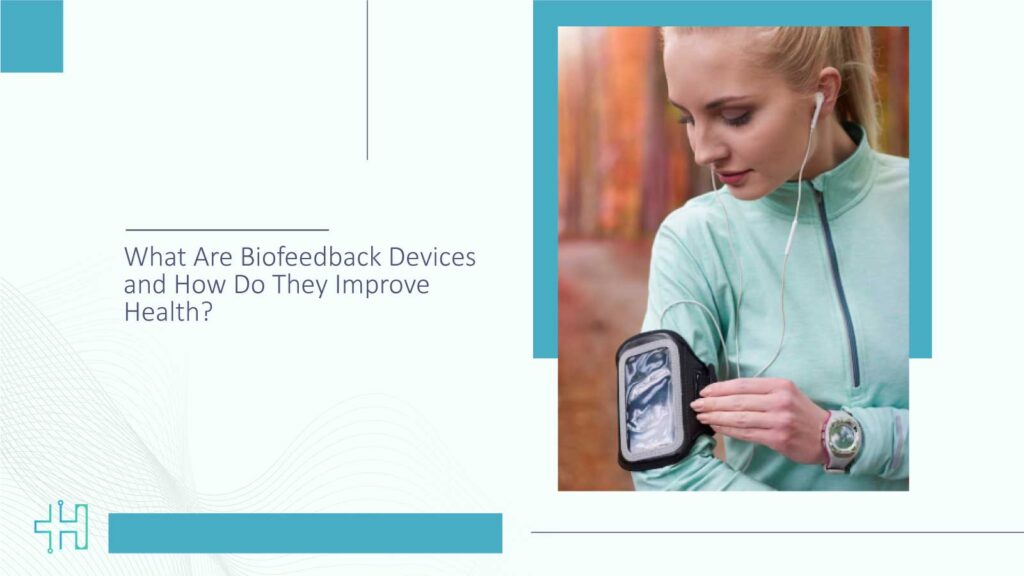Can you visualize yourself using your mind alone to adjust your heart rate, muscle tension, or stress levels? The real-time bodily functions information that biofeedback devices offer is what makes the whole thing possible. This is because they help people gain awareness and influence those processes that usually happen automatically.
By the time biofeedback was introduced in the 1960s, the technology had been used to treat various diseases as well as to promote human health. Besides that, it gives people a convenient as well as a non-intrusive way of elevating their physical and mental health through the combination of technology and self-regulation methods. Hence, it is now easier than ever to achieve user wellness wherever they want.
What Are Biofeedback Devices?
Biofeedback devices are the things that can check your heart rate, muscle tension, skin temperature, and brain wave activity. These devices inform how the body is functioning at the very moment (in some cases by indicating the numbers on the screen) and do not allow individuals to see and therefore to control the bodily functions. The main forms of biofeedback are:
- Electromyography (EMG) Biofeedback: Along with the muscle tension, it gives a visual representation to the user, so one can understand the movements of the muscles in this case.
- Thermal Biofeedback is a practice that changes human skin into a heat radiation source.
- Heart Rate Variability (HRV) Biofeedback: This procedure assesses the heart rate to determine the variations of the intervals between the beats (RR).
- Neurofeedback: The method of predicting brain wave activity.
There are lots of places where this kind of equipment is welcomed, such as clinics, sports facilities, and houses of people who take care of their health.
Understanding How Biofeedback Works
One function of body parts that are usually automatic becomes measurable and can be visualized or heard through biofeedback. Brain systems try to keep your body in a state of perfect balance in terms of such things as heart rate, struggle, and breath. It is sometimes the case that all bodily functions happen without knowledge and conscious control.
The physiological signals are measured by biofeedback devices, and these signals are displayed in real time through graphs, sounds, or lights. Such a reaction helps one to find out how his or her body reacts to various influences such as stress, movement, or relaxation exercises. In the process of learning to influence one’s bodily responses, one achieves which is the ultimate goal of self-regulation to bring about health improvement.
How Do Biofeedback Devices Improve Health?
Biofeedback devices offer a non-invasive, drug-free approach to health improvement. By enhancing self-awareness and promoting self-regulation, these devices help individuals manage and alleviate symptoms associated with various conditions.
1. Stress Reduction
Chronic stress can lead to a myriad of health issues, including hypertension, anxiety, and sleep disturbances. Biofeedback helps individuals recognize physiological signs of stress, such as increased heart rate or muscle tension, and teaches techniques to counteract these responses.
2. Pain Management
Biofeedback has been effectively used to manage chronic pain conditions, including headaches, back pain, and arthritis. By learning to control muscle tension and other physiological responses, individuals can reduce the intensity and frequency of pain episodes. A study by the Veterans Affairs Research Communications found that biofeedback could reduce headache pain and aid in stroke recovery.
3. Improved Mental Health
Mental health conditions such as anxiety and depression can benefit from biofeedback therapy. Neurofeedback, a type of biofeedback that targets brain wave activity, has been shown to improve symptoms of these conditions by training individuals to achieve desired brain states. Research indicates that neurofeedback can trigger positive behavioral outcomes, such as relieving symptoms related to psychiatric disorders.
4. Enhanced Physical Rehabilitation
Biofeedback is a valuable tool in physical therapy and rehabilitation. It assists individuals in regaining control over motor functions and improving posture and balance. For example, a study demonstrated that plantar pressure-based electro-tactile biofeedback could suppress postural destabilization induced by trunk extensor muscle fatigue.
Types of Biofeedback Devices
Biofeedback options vary in number and include different types of medical devices that provide information about the body’s functions.
1. Electromyography (EMG) Biofeedback – EMG devices are those instruments that record electrical activity in the muscles, as well as the amount of muscle tension. It can be used for headaches, back pain, and tension-related disorders caused by muscular imbalance, etc. Besides that, by working with the user, a physiotherapist can teach the user how to calm the muscles themselves, which leads to treatment via relaxation of the muscles involved. For example, NeuroSky EMG sensors.
2. Thermal Biofeedback – The measurement that takes place in this method is the one of skin temperature, which is a parameter that is very sensitive to blood circulation and stress. Users gain knowledge on how peripheral blood flow can be increased, which allows them to overcome stress, anxiety, and migraine symptoms.
3. Heart Rate Variability (HRV) Biofeedback – HRV devices measure the variability of the intervals between heartbeats. The practice of breathing and relaxing allows users to modulate heart rate variability patterns, thus decreasing their stress levels and improving cardiovascular health.
4. Neurofeedback – Neurofeedback identifies brain wave activities through the use of EEG sensors. Non-invasive brain mapping techniques provide effective cognitive therapy and learning by changing and preserving healthy patterns of neuronal activity in the brain, which helps reduce anxiety, improve concentration, and alleviate the symptoms of mental health disorders.
Taking Control of Your Health with Biofeedback
Overall, biofeedback machines are the most powerful instruments for the attainment of better health. By fostering awareness and self-regulation, the devices give an individual the ability to control their physiological functions, leading to better physical and mental health. In addition, as technology progresses, there is a broad range of new possible uses for biofeedback, which affords great opportunities for patients having different health conditions.
If so, one can say that the use of biofeedback is a good choice if a person aims at stress reduction, pain alleviation, or taking their physical abilities to a higher level. Nevertheless, with the continued research and innovation, there will be new horizons and health solutions that will be enriched by the use of biofeedback devices.
FAQs
1. What is a biofeedback device?
A biofeedback device is an instrument that detects biological signals of the user, such as heart rate, brain activity, muscle tension, and skin temperature. It provides data immediately to facilitate the user’s monitoring of the body’s functions and, in case of need, to return to the normal or improved condition of health.
2. What are the benefits of biofeedback therapy?
Among the benefits of biofeedback therapy are stress reduction, pain alleviation, enhancement of mental well-being, and support for physical rehabilitation. The self-regulation training grants users control over their autonomic functions and thereby improves their overall health.
3. Are home biofeedback devices safe?
Indeed, most of them are non-invasive and safe enough for home use. Nevertheless, it is recommended to consult a professional before embarking on a treatment with such a device, especially if you have a health condition or are in therapy.
4. What kinds of biofeedback devices exist?
There are four major types: EMG (muscle tension), thermal (skin temperature), HRV (heart rate variability), and neurofeedback (brain waves). Depending on the user’s condition and requirements, such as relaxation, pain relief, concentration, or mood stabilization, one or a mixture of these modalities may be selected.
5. How long is the process to see the improvement?
The period to see the improvement varies from user to problem. A few biofeedback sessions may suffice for some users to experience stress relief or better concentration, but in the case of chronic pain and physiotherapy, usually, several weeks of consistent practice are required.
Keep reading on Health Technology Insights.
To participate in our interviews, please write to our HealthTech Media Room at sudipto@intentamplify.com








